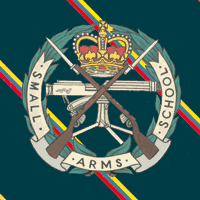School of Musketry
| Small Arms School Corps | |
|---|---|

Small Arms School Corps cap badge
|
|
| Active | 1853-Present |
| Country |
|
| Branch |
|
| Role | Small arms training |
| Garrison/HQ | Land Warfare Centre, Warminster |
| March | March of the Bowmen from the Robin Hood suite |
The Small Arms School Corps (SASC) is a small corps of the British Army, established in 1853 by Lord Hardinge, and responsible for maintaining the proficiency of the army in the use of small arms, support weapons and range management.
Prior to 1838 the majority of British soldiers were issued with the "Brown Bess" Land Pattern Musket, a smooth-bore, muzzle loading black powder flintlock musket which had seen service in one form or another since 1722.
In 1849, Claude-Étienne Minié produced the Minié rifle, although still a muzzle loader three important advances were incorporated. Firstly it utilises a rifled bore; secondly used an expanding bullet that a) improved accuracy out to 600 yards and b) greatly reduced the time required for reloading a rifle and thirdly incorporated percussion cap ignition of the black powder charge. Re-equipment of the Army with this new firearm being adopted in 1851, by the British Army through to 1855.
The consequence of this was that the army now had a weapon that was more accurate, at a longer range, was quicker to load and was marginally safer for the user as to ignition. For the first time since the demise of the bow and arrow lethal marksmanship was possible. Shooting ceased to be a drill and became an art based on personal skill. Elevation, windage and ballistics now played a part. In order to study these new problems and introduce a shooting doctrine for instruction in Rifle Shooting it was decided to form a special Corps of experts, who would also develop and improve the rifles and those whom use them. In March 1853 the Army Estimates included the sum of £1,000 (about £91,300 today) for Lord Hardinge to form an "Establishment for the instruction of the Army in rifle and target practice."
In June 1853 Colonel Hay arrived at Hythe, Kent, with a small staff of officers. On 1 August the first instructor, Colour Sergeant MacKay of the 19th Foot, was appointed. By 15 September a further three instructors were on strength. They were Sergeant Ruston (3 Gren Gds), Sergeant Lobes (2 Gren Gds) and Sergeant Morris (97th Regt). The first mention of the establishment of the School was in the Army List of 1854 when it was referred to as the School of Musketry.
...
Wikipedia
